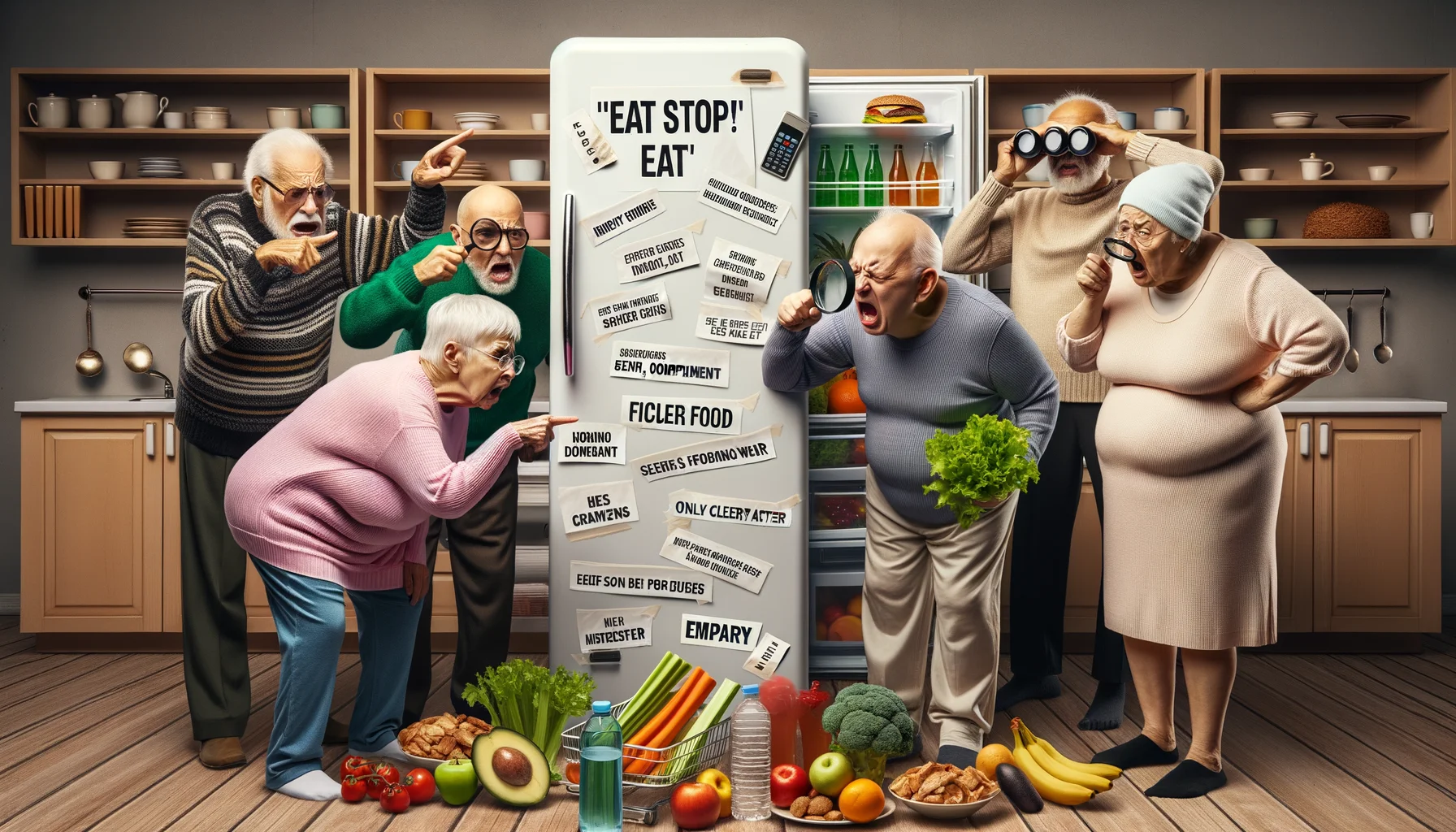Eat stop eat complaints Quiz
Test Your Knowledge
Question of
Understanding Eat Stop Eat
Origins of the Eat Stop Eat Method
The Eat Stop Eat approach is a revolutionary take on intermittent fasting, which has been gaining traction in the health and fitness world. This method simplifies the process of fasting, making it an accessible option for those looking to improve their health and manage their weight.
The Creator: Brad Pilon A nutrition expert and a former sports supplement developer, Brad Pilon, crafted the Eat Stop Eat method after extensive research. His approach has demystified fasting for the masses and presented a flexible alternative to traditional dieting.
The Intermittent Fasting Concept At its core, intermittent fasting involves alternating periods of eating with periods of abstention from food. The Eat Stop Eat method emphasizes short-term fasts that are strategically placed to optimize fat loss and muscle maintenance.
Scientific Research and Foundations Underpinning this method is a robust body of scientific research. Studies have shown that intermittent fasting can lead to improved metabolic health, increased longevity, and effective weight management.
Core Principles of Eat Stop Eat
The essence of the Eat Stop Eat program lies in its simplicity and adaptability. By focusing on just a few key principles, individuals can tailor the method to fit their lifestyles while still reaping significant health benefits.
- Fasting Schedules and Frequency: The hallmark of this method is the 24-hour fast done once or twice a week. This flexibility allows individuals to choose which days to fast based on their schedules and personal preferences.
- Caloric Intake and Nutritional Guidelines: During non-fasting days, there's an emphasis on balanced eating without strict calorie counting. The focus is on consuming whole foods that provide essential nutrients without overindulgence.
- Exercise Recommendations: Physical activity is encouraged alongside the fasting protocol. However, there's no need for excessive exercise; consistent, moderate activity complements the fasting process effectively.
Apart from these principles, it's crucial to stay adequately hydrated during fasts and ensure that any physical activity is aligned with energy levels. With these guidelines in mind, many find the Eat Stop Eat methodology both effective and sustainable over the long term.
Maintaining a balance between fasting days and regular eating habits is key when following the Eat Stop Eat program. It's not just about weight loss; it's about fostering a healthier relationship with food and improving overall well-being.
Common Concerns with Eat Stop Eat
Difficulty in Adapting to Fasting
Embarking on the Eat Stop Eat journey can be a rollercoaster! It's normal to face hurdles as your body transitions from its usual routine to periods of fasting. This change requires mental and physical adjustments, but don't worry, it's a mountain worth climbing!
Hunger pangs might feel like your biggest adversary at first. These sensations are not just gut feelings; they're real challenges on this journey. But remember, they are temporary visitors that tend to decrease as your body adapts to the new eating pattern.
It's not uncommon to experience energy dips during fasting windows. While these moments may tempt you to reach for a quick snack, stay strong! Your body is learning to tap into its stored energy, and soon you'll be sailing through the day with vigor.
Social gatherings and lifestyle habits might need a tweak or two when you're on Eat Stop Eat. But fear not, with a bit of planning and communication, you can still enjoy life's festivities and maintain your fasting schedule. It's all about finding that sweet balance!
Managing Hunger Pangs
- Stay Hydrated: Sip water throughout your fast to help stave off hunger.
- Distract Yourself: Engage in activities that keep your mind off food.
- Plan Your Meals: Have nutritious meals ready for when you break your fast.
- Mindful Eating: When you do eat, focus on savoring each bite to increase satisfaction.
- Avoid Sugary Beverages: These can spike your hunger levels even more.
- Consistency is Key: Stick to a regular fasting schedule for better adaptation.
Coping with Energy Lulls
Eat Stop Eat may initially bring about some unwelcome sluggishness, but don't let that dim your spark! Your body is simply switching gears from glucose to fat burning. Embrace this shift as a positive stride towards enhanced energy efficiency!
To combat these sporadic energy drops, focus on consuming nutrient-dense foods during your eating periods. Foods high in protein, healthy fats, and fiber will provide sustained energy release, helping smooth out those energy curves.
Social and Lifestyle Adjustments
Navigating social situations while maintaining your fasting regimen can be tricky but absolutely doable. Communicate openly with friends and family about your lifestyle choice. Most people will support your commitment once they understand it!
Lifestyle adjustments are part of the process. You may need to reorganize meal times or switch up workout routines. However, these changes often lead to new habits that could be healthier and more rewarding in the long run!
Potential Health Implications
Short-Term Side Effects
The initial phase of Eat Stop Eat might greet you with some short-term side effects like headaches or irritability. These are signs that your body is adjustinghang tight! They typically ease up as you become more accustomed to the fasting periods.
Long-Term Health Risks
Fasting regimens like Eat Stop Eat have been scrutinized for their long-term impact on health. While many people thrive on such plans, it's crucial to listen to your body and consult healthcare professionals regularly to ensure it's the right path for you.
Addressing Nutrient Deficiencies
A pivotal aspect of Eat Stop Eat is ensuring nutritional adequacy despite reduced eating windows. Prioritize a varied diet rich in essential vitamins and minerals when you eat, so your body doesn't miss out on any key nutrients!
Comparing Diet Strategies
Eat Stop Eat vs. Traditional Diets
Calorie Restriction Methods are the backbone of any diet, but how they're implemented can vary dramatically. Eat Stop Eat champions intermittent fasting, involving 24-hour fasts once or twice a week. In contrast, traditional diets often suggest reducing daily caloric intake. This stark difference influences not just weight loss but also lifestyle and metabolic responses.
Sustained Weight Loss Results can be seen in both approaches, yet the mechanisms differ. Traditional diets rely on consistent calorie reduction, which can lead to gradual weight loss over time. Conversely, Eat Stop Eat may offer metabolic advantages by intermittently boosting growth hormone levels and increasing fat oxidation, potentially leading to quicker results.
Ease of Adherence is crucial for long-term success in any diet. Traditional diets require daily vigilance which can be cumbersome for some. Meanwhile, Eat Stop Eat demands discipline on fasting days but allows more flexibility on non-fasting days, which may be easier for those who prefer less frequent dietary restrictions.
Intermittent Fasting Variations
The 16/8 Method involves fasting for 16 hours each day and eating during an 8-hour window. This method is popular for its simplicity and adaptability to daily routines. By aligning the fasting period with sleep and busy mornings, adherence becomes more manageable for many individuals.
The 5:2 Approach takes a different angle by allowing normal eating for five days of the week while drastically restricting calories on two non-consecutive days. This method is often praised for its psychological ease since dieters do not feel restricted most days of the week.
Alternate-Day Fasting is a more intense variation where individuals alternate between no food intake for 24 hours and eating normally the next day. This pattern requires a significant amount of self-control and adjustment but can lead to impressive health benefits for those who can maintain it consistently.
- Tips for Success:
- Pick a method that fits your lifestyle to enhance adherence.
- Stay hydrated during fasting periods to maintain energy levels.
- Eat nutrient-dense foods during eating windows to maximize health benefits.
- Gradually ease into intermittent fasting to allow your body to adjust.
- Avoid binge eating after fasting periods to prevent counterproductive results.
- Consider combining intermittent fasting with exercise for enhanced weight loss and fitness gains.
- Monitor your progress and adjust your approach as needed based on your results and well-being.
Success Stories and Testimonials
Weight Loss Achievements
The journey to weight loss is filled with triumphs that deserve celebration. Real-life success stories often start with individuals setting clear, achievable goals and committing to a structured plan. These narratives inspire and showcase the power of dedication.
Personal milestones vary from the first 5 pounds lost to the last step of a marathon. Each milestone marks a significant victory in an individuals weight loss journey, acting as a beacon of progress and motivation for others contemplating similar paths.
Body composition changes are not just about shedding weight but also about gaining strength and vitality. Success stories often highlight increased muscle tone, improved endurance, and a greater sense of well-being through consistent exercise and healthy eating habits.
Health markers such as blood pressure, cholesterol levels, and blood sugar levels are critical indicators of overall health improvement. Many weight loss testimonials proudly share their health transformations backed by medical data, reinforcing the life-changing impact of their efforts.
Challenges Overcome
Battling emotional eating is a common challenge highlighted in many success stories. Overcoming this requires not just physical changes but also mental resilience. Stories often tell of strategies like mindfulness practices and support networks that help individuals navigate these battles.
Breaking through a plateau can be one of the most frustrating experiences on the road to weight loss. However, testimonials provide real-world proof that with adaptive strategies and perseverance, these plateaus can be conquered, leading to renewed progress.
- Vary Your Routine: Introduce new exercises or activities to keep your body challenged.
- Nutritional Tweaks: Adjust your diet to overcome metabolic adaptations.
- Seek Support: Connect with a community or hire a coach for fresh perspectives and encouragement.
- Rest and Recover: Ensure adequate rest to prevent burnout and promote recovery.
- Data Tracking: Use apps or journals to track your progress meticulously; sometimes small changes make big differences over time.
Maintaining motivation is pivotal for long-term success in any weight loss endeavor. Success stories often emphasize the importance of setting new goals, celebrating small victories, and reflecting on how far one has come when motivation starts to wane.
Intrinsic motivation proves to be a powerful tool; finding personal reasons for losing weight that go beyond aestheticslike improving health or enhancing quality of lifecan create an enduring drive towards achieving one's goals.
Nutrition and Meal Planning
Crafting a Balanced Diet
Embarking on the journey to a balanced diet begins with understanding the roles and proportions of macronutrients. Carbohydrates, proteins, and fats are the cornerstone of energy supply, muscle repair, and cellular function. Tailoring your intake to suit your lifestyle can ignite your metabolism and enhance overall well-being.
Macronutrient Ratios are not one-size-fits-all. The key is to find a balance that supports your activity level and personal health goals. For instance, athletes may require more carbohydrates for energy, while someone focusing on weight loss might aim for a higher protein intake to aid satiety and muscle maintenance.
Micronutrients might be tiny in name but they pack a mighty punch when it comes to health. Vitamins and minerals are essential for optimal body function, playing critical roles in everything from bone health to immune response. Igniting your diet with a rainbow of fruits and vegetables ensures a broad spectrum of these nutritional powerhouses.
Hydration and Fasting are pivotal elements of nutrition. While water fuels every cell in your body, strategic fasting can reset your system and boost metabolic health. But remember, during fasting periods, staying hydrated becomes even more crucial to maintain bodily functions and detoxify effectively.
Recipe Ideas and Food Choices
Fasting-Friendly Snacks are vital for those practicing intermittent fasting or those who need sustenance without breaking their fast completely. Think nutrient-dense foods like nuts, seeds, or yogurt that provide energy without spiking blood sugar levels.
Post-Fasting Meals are your opportunity to replenish and nourish. Focus on high-quality proteins, healthy fats, and complex carbohydrates that will fuel recovery without overwhelming the digestive system. A grilled chicken salad or salmon with quinoa are stellar examples of post-fasting meals that pack both flavor and nutrition.
Vegetarian and Vegan Options abound for those who abstain from animal products. Legumes, tofu, tempeh, and a multitude of grains offer ample protein while nuts, seeds, avocados provide healthy fats. Plant-based eating can be both diverse and delicious when creativity meets fresh ingredients.
- Pre-Plan Your Meals: Take time each week to map out your meals to avoid last-minute unhealthy choices.
- Balance Your Plate: Aim for half your plate to be fruits and vegetables, a quarter protein, and a quarter whole grains.
- Stay Seasonal: Choose seasonal produce for peak flavor and nutrition at a lower cost.
- Mindful Eating: Pay attention to hunger cues and eat slowly to enjoy every bite.
- Hydration is Key: Don't mistake thirst for hunger; drink water throughout the day.
- Experiment with Herbs & Spices: Enhance flavors without adding extra salt or sugar.
- Savor Every Snack: Choose snacks that satisfy hunger pangs while providing nutrients like fiber or protein.
Exercise and Physical Activity
Integrating Exercise with Fasting
Combining fasting with exercise can be a game-changer for your fitness goals! It's all about finding the perfect balance that fuels your body while still allowing you to reap the benefits of fasting. The synergy between these two can enhance fat loss, improve metabolic health, and even boost mental clarity. But remember, it's crucial to listen to your body and adjust accordingly.
Best Practices for Training during fasting include staying hydrated and being mindful of your energy levels. Opt for moderate-intensity workouts, especially if you're new to combining fasting with exercise. This approach helps prevent burnout and maintains performance. Also, don't forget to refuel properly post-workout to maximize recovery!
- Timing Workouts with Fasts: Strategically planning your workouts can make all the difference. Aim for a workout window towards the end of your fasting period. This can lead to optimal fat burning! However, if you're feeling sluggish, a light workout earlier in the fast might be more suitable.
- Recovery and Rest Periods: After exercising during a fast, give your body the rest it deserves. Recovery is when the magic happens muscles repair, adapt, and grow stronger. Ensure you're getting enough sleep and consider gentle activities like walking or yoga on rest days.
Types of Beneficial Exercises
There's a whole universe of exercises out there, but focusing on key types can amplify your results! Each form of exercise brings unique benefits and targeting a mix can lead to comprehensive fitness gains. Lets dive into some of the most impactful routines!
Cardiovascular Routines
Cardiovascular Routines are your heart's best friend! Regular cardio boosts heart health, burns calories, and elevates mood. Whether it's running, cycling, or swimming, aim for at least 150 minutes of moderate-intensity cardio per week as recommended by health authorities.
Strength Training Regimens
Strength Training Regimens , oh boy, they are essential! Lifting weights or using resistance bands not only builds muscle but also strengthens bones and helps control body weight. Aim for two or more days a week focusing on major muscle groups for balanced strength development.
Flexibility and Balance Workouts
Last but not least, let's talk about Flexibility and Balance Workouts . These exercises reduce the risk of injury and improve overall performance. Incorporating yoga or Pilates into your routine can enhance flexibility, while balance exercises like tai chi can prevent falls especially as we age.
Overcoming Plateaus and Setbacks
Identifying Common Stalling Points
Metabolic Adaptation is a natural occurrence where your body becomes more efficient at utilizing calories, potentially slowing weight loss. Recognizing this can help you reassess your dietary intake and exercise routine to reignite progress.
Inconsistent Fasting Patterns can confuse your body's hunger cues and metabolic rate, leading to a plateau. Maintaining a consistent fasting schedule is crucial for steady progress and metabolic stability.
Psychological Factors Affecting Progress are often underestimated. Stress, sleep quality, and emotional eating can all create barriers to success. Addressing these factors is essential for overcoming plateaus.
Strategies for Continued Success
Adjusting the Fasting Schedule may be necessary as your body adapts. Experimenting with different fasting windows or types of intermittent fasting can jumpstart your metabolism and break through plateaus.
Reevaluating Caloric Needs is a proactive step as weight loss progresses. Your caloric requirements may decrease as you lose weight, so it's important to adjust your intake accordingly for continued success.
- Maintain a Food Diary: Tracking what you eat can highlight areas for improvement.
- Vary Your Exercise Routine: Introducing new exercises can challenge your body in new ways.
- Incorporate Strength Training: Building muscle mass can increase metabolic rate and aid in breaking plateaus.
- Avoid Overrestriction: Eating too few calories can slow down metabolism, so ensure you're eating enough to support your activity level.
- Schedule Regular Reassessments: Regular check-ins on progress can help you make timely adjustments to your plan.
- Prioritize Sleep: Lack of sleep can hinder weight loss efforts, so aim for 7-9 hours per night.
- Seek Professional Guidance: A dietitian or personal trainer can offer personalized advice tailored to your specific needs.
Finding a support system or seeking accountability can be transformative. Joining groups, hiring a coach, or partnering with a friend on a similar journey can provide motivation and encouragement when facing setbacks.
Long-Term Sustainability of Eat Stop Eat
Lifestyle Integration Tips
Integrating the Eat Stop Eat approach into your daily life can be seamless when you understand its flexibility. It's not about harsh restrictions but about finding a balance that works for you. With some planning and mindfulness, this intermittent fasting method can become second nature, aligning with your body's natural hunger cues and contributing to overall well-being.
Consistency is key for success with Eat Stop Eat. Establishing a routine fasting schedule that fits your lifestyle can help mitigate hunger pangs and maintain energy levels. It's important to listen to your body and adjust fasting periods as needed, ensuring that the practice enhances rather than hinders your daily activities.
Balancing Social Engagements
Social events don't have to be obstacles for those practicing Eat Stop Eat. With strategic planning, you can schedule fasting periods around such gatherings. This allows you to fully engage in social dining without compromising your fasting goals. Remember, intermittent fasting is about flexibility; it should enhance your life, not restrict it.
Communication is vital when navigating social situations. Don't hesitate to explain your eating patterns to friends and family. Most will be supportive and may even become curious about the benefits you're experiencing. Sharing your journey can also help normalize intermittent fasting within your social circle.
Travel and Vacation Considerations
Traveling while maintaining the Eat Stop Eat protocol requires a bit of foresight but is entirely manageable. Plan your fasting days around travel schedules or consider shorter fasting windows during vacations. The adaptability of Eat Stop Eat means you can always get back on track after indulgent periods without guilt.
Staying hydrated and being mindful of local cuisines are crucial when traveling. Opt for nutrient-dense foods during eating windows to maximize health benefits and sustain energy levels during fasting times. Always prioritize enjoyment on vacation, knowing that the flexibility of Eat Stop Eat accommodates occasional deviations.
Managing Special Occasions
Special occasions should be enjoyed to the fullest, which is why the Eat Stop Eat method doesn't require you to miss out on celebrations. By planning fasting days before or after events, you can partake in festivities guilt-free. This approach ensures that intermittent fasting complements rather than complicates these memorable moments.
- Plan Ahead: Align fasting schedules with upcoming events.
- Stay Hydrated: Drink plenty of water before and after indulgent meals.
- Moderation: Enjoy treats in moderation during eating windows.
- Resume Routine: Return to regular fasting patterns post-celebration.
Future Prospects and Research
The future shines brightly for intermittent fasting as research continues to uncover its potential health benefits. Studies focusing on longevity, metabolic health, and cognitive function are particularly promising, suggesting that practices like Eat Stop Eat could play a significant role in preventive healthcare strategies.
The evolving landscape of nutritional science promises more refined guidelines for intermittent fasting protocols like Eat Stop Eat. As we learn more about individual responses to fasting, personalization will become increasingly important in recommendations, catering to unique physiological needs for optimal results.
Ongoing Studies on Intermittent Fasting
Ongoing research into intermittent fasting is delving deeper into its mechanisms and long-term impacts on human health. These studies are critical as they provide empirical evidence supporting the practice, paving the way for broader acceptance among healthcare professionals and dietitians.
The scientific community remains excited about the potential of intermittent fasting as a tool for disease prevention and management. As new findings emerge, they will undoubtedly influence how we approach weight loss, nutrition, and overall health maintenance in exciting ways!
Evolving Guidelines and Recommendations
Eat Stop Eat's guidelines are set to evolve with the growing body of research supporting its efficacy. Nutrition experts are continually revising recommendations based on emerging evidence, ensuring that advice remains current, safe, and beneficial for practitioners worldwide.
The adaptability of intermittent fasting guidelines means individuals can tailor their approach to fit personal preferences and lifestyles while still reaping significant health benefits. These personalized strategies make adherence more sustainable over the long term.
The Role of Community and Support Networks
The role of community cannot be overstated in sustaining practices like Eat Stop Eat over time. Peer support networks provide motivation, share experiences, and offer guidance through challenges associated with intermittent fasting lifestyles.
Digital platforms have become hubs for these communities where individuals connect from across the globe. The collective wisdom found within these groups can be invaluable in helping newcomers navigate their journey toward improved health through practices like Eat Stop Eat.












